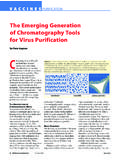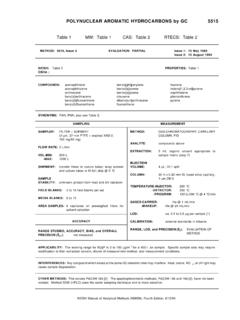Transcription of Comparison of Activated Carbons - SAWEA
1 Activated CarbonsActivated CarbonsFor Wastewater Odor ControlFor Wastewater Odor ControlDeepak RainaDeepak RainaY. B. A. Kanoo B. A. Kanoo OverviewPresentation Overview Review of odor control of odor control basics. Review of Activated carbon of Activated carbon basics. Activated Carbons and odor Carbons and odor of Odor Control Review of Odor Control BasicsBasics Odors are produced primarily in two areas:Odors are produced primarily in two areas: Wastewater Treatment Plants (WWTP)Wastewater Treatment Plants (WWTP)
2 HeadworksHeadworks Clarification SystemsClarification Systems Biological SystemsBiological Systems Solids ProcessingSolids Processing Collection System FacilitiesCollection System Facilities Force Main DischargesForce Main Discharges Pump / Lift StationsPump / Lift Stations Transition StructuresTransition StructuresNature of Odors Nature of Odors Odorous compounds in wastewater include Odorous compounds in wastewater include both inorganic and organic inorganic and organic gases. Primary inorganic odorous compounds: Primary inorganic odorous compounds: Hydrogen Sulfide (HHydrogen Sulfide (H22S)S) Ammonia (NHAmmonia (NH33)) Common organic odorous compounds:Common organic odorous compounds.
3 Methyl Mercaptan (CHMethyl Mercaptan (CH33SH)SH) Dimethyl Sulfide ( (CHDimethyl Sulfide ( (CH33))22S )S ) Indole (CIndole (C66HH44(CH)(CH)22NH)NH)Odor GenerationOdor Generation Odors are ordinarily generated when turbulence in the Odors are ordinarily generated when turbulence in the wastewater stream volatilizes the odorous compounds from the wastewater stream volatilizes the odorous compounds from the Odors from inorganic compounds (Odors from inorganic compounds (primarily Hprimarily H22SS) dominate the ) dominate the Collection System.
4 Odors at the WWTP generally originate from a mixture of Odors at the WWTP generally originate from a mixture of inorganic and organic compounds. inorganic and organic compounds. However, even here, HHowever, even here, H22S S tends to be the major odor to be the major odor of Odor ControlImportance of Odor Control Factors influencing growing importance of controlling Factors influencing growing importance of controlling odors include:odors include: Encroachment of new residential and commercial Encroachment of new residential and commercial development near once isolated wastewater facilities.
5 Development near once isolated wastewater facilities. New neighbors do not want to smell odors!New neighbors do not want to smell odors! Increased waste loadings being carried by collection Increased waste loadings being carried by collection systems and treated by systems and treated by WWTPsWWTP sfueling expansion of expansion of plants. Another result of population growth and encroachment!Another result of population growth and encroachment!Review of Activated CarbonReview of Activated carbon Definition of Activated carbon :Definition of Activated carbon .
6 Activated carbon is a crude form of Activated carbon is a crude form of graphite with a random or amorphous graphite with a random or amorphous platelet structure, which is highly porous platelet structure, which is highly porous over a broad range of pore sizes, from over a broad range of pore sizes, from visible cracks and crevices to cracks and visible cracks and crevices to cracks and crevices of molecular of molecular Structure of Activated The Structure of Activated CarbonCarbon This is a conceptual view of This is a conceptual view of the structure of Activated the structure of Activated carbon , magnified carbon , magnified 10,000,000 times.
7 10,000,000 times. The carbon shown is a The carbon shown is a standard, unimpregnated, standard, unimpregnated, bituminous coal based 1/2,500,000 of an inch1000 angstromsAliphatic dislocation of plateletGraphite Plateletbituminous coal based is Activated carbon How is Activated carbon Made?Made? Activated carbon is made in one of two Activated carbon is made in one of two ways:ways: Direct ActivationDirect Activation ReagglomerationReagglomerationDiagram showing reagglomerated carbon manufacturing Activated CarbonDirect Activated carbon Direct Activation:Direct Activation: Starting material is crushed to desired final size Starting material is crushed to desired final size and fed into activation furnace.
8 And fed into activation furnace. Virtually all Carbons are made this way, as it is Virtually all Carbons are made this way, as it is easier, requires less capital equipment, and is easier, requires less capital equipment, and is therefore less expensive. therefore less expensive. Reagglomerated CarbonReagglomerated carbon Reagglomeration:Reagglomeration: Starting material is crushed to a powder. It is then Starting material is crushed to a powder. It is then recombined (reagglomerated) with a binder into a recombined (reagglomerated) with a binder into a briquette.
9 The briquette is then crushed to the final briquette. The briquette is then crushed to the final desired size and fed into the activation size and fed into the activation furnace. This method provides much greater surface area than This method provides much greater surface area than direct activation. Resultant adsorption capacity is activation. Resultant adsorption capacity is is Activated carbon What is Activated carbon made of ?made of ? Any carbonaceous material can be a starting Any carbonaceous material can be a starting material for Activated carbon :material for Activated carbon : Coal (typically bituminous)Coal (typically bituminous) Coconut shellCoconut shell WoodWood Even blood and animal bones !
10 Even blood and animal bones ! How does Activated carbon How does Activated carbon Work?Work? Most Activated Carbons work primarily through the Most Activated Carbons work primarily through the mechanism of mechanism of Physical AdsorptionPhysical Some Activated Carbons used in odor control work Some Activated Carbons used in odor control work primarily through other means:primarily through other means: ChemisorptionChemisorption Catalytic AdsorptionCatalytic AdsorptionPhysical AdsorptionPhysical Adsorption Based on Based on London Dispersion ForcesLondon Dispersion Forces.







